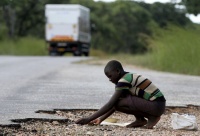Battle for development cash heats up at IMF/World Bank meetings
Battle for development cash heats up at IMF/World Bank meetings StreetInsider.com


Development Agencies Face Tough Battle to Secure Funding for Poorest Countries

By Libby George and Karin Strohecker
Introduction
Development agencies are gathering in Washington this week to address the challenge of securing more funding for the world’s poorest countries. The poor world’s development is regressing at an alarming rate due to debt crises, high global interest rates, and increasing investment needs. Additionally, there is a pressing need for trillions of dollars per year to achieve climate spending goals. However, the rich world’s attention is primarily focused on wars abroad and domestic elections, making it difficult to garner support for development aid.
Funding Challenges
During the last round of IMF and World Bank meetings in October, global leaders anticipated a faster easing of rich-world inflation and interest rate cuts to alleviate financing costs. However, the expanding conflict in the Middle East and the ongoing war in Ukraine have added additional funding pressures, dampening the rich world’s willingness to invest in development aid. Budgetary constraints in many countries are increasing, with more expenditure allocated to defense rather than development aid.
The Role of Lenders
Lenders such as the World Bank’s International Development Association (IDA) will play a crucial role in determining the rich world’s willingness to donate. IDA, which targets record commitments above its previous replenishment of $93 billion, has already started issuing bonds to leverage its lending. However, many high- and middle-income countries that previously contributed to IDA are experiencing donor fatigue. France and the UK have made significant cuts to overseas aid, while political battles in the United States have stalled foreign spending commitments.
Impact on Developing Countries
A recent United Nations report revealed that although official development assistance globally reached a record high in 2022, the share allocated to developing countries decreased by 2%. This challenging environment poses a perfect storm for poor countries. In the aftermath of the global financial crisis, money flowed freely with low interest rates, resulting in a significant increase in external public debt stock in low and middle-income countries. However, China, a major lender during that period, has since reduced its lending due to domestic debt problems, limiting the availability of affordable finance for developing countries.
The Importance of Multilateral Lenders
Multilateral lenders such as IDA and the European Bank for Reconstruction and Development (EBRD) play a crucial role in providing concessional finance to developing countries. This support can encourage private lenders and eurobond investors to contribute as well. The endorsement from these multilateral bodies signals confidence in the reform efforts of recipient countries. However, securing commitments from donor countries remains a challenging task due to fiscal constraints worldwide.
Conclusion
Securing funding for the world’s poorest countries is an uphill battle for development agencies. The current global situation, with its focus on wars and domestic elections, has led to reduced appetite for development aid. Additionally, debt crises, high interest rates, and climate spending goals further exacerbate the challenges faced by developing countries. Multilateral lenders play a vital role in providing concessional finance and encouraging other investors to contribute. However, fiscal constraints worldwide make securing commitments a daunting task.
(Reporting by Libby George and Karin Strohecker; editing by Christina Fincher)
SDGs, Targets, and Indicators in the Article
1. Which SDGs are addressed or connected to the issues highlighted in the article?
- SDG 1: No Poverty
- SDG 8: Decent Work and Economic Growth
- SDG 10: Reduced Inequalities
- SDG 13: Climate Action
- SDG 17: Partnerships for the Goals
2. What specific targets under those SDGs can be identified based on the article’s content?
- Target 1.2: By 2030, reduce at least by half the proportion of men, women, and children of all ages living in poverty in all its dimensions according to national definitions.
- Target 8.1: Sustain per capita economic growth in accordance with national circumstances and, in particular, at least 7 percent gross domestic product growth per annum in the least developed countries.
- Target 10.1: By 2030, progressively achieve and sustain income growth of the bottom 40 percent of the population at a rate higher than the national average.
- Target 13.1: Strengthen resilience and adaptive capacity to climate-related hazards and natural disasters in all countries.
- Target 17.2: Increase the level of international cooperation to facilitate access to clean energy research and technology, including renewable energy, energy efficiency, and advanced and cleaner fossil-fuel technology, and promote investment in energy infrastructure and clean energy technology.
3. Are there any indicators mentioned or implied in the article that can be used to measure progress towards the identified targets?
- Indicator 1.2.1: Proportion of population living below the national poverty line, by sex and age.
- Indicator 8.1.1: Annual growth rate of real GDP per capita.
- Indicator 10.1.1: Growth rates of household expenditure or income per capita among the bottom 40 percent of the population and the total population.
- Indicator 13.1.1: Number of deaths, missing persons, and directly affected persons attributed to disasters per 100,000 population.
- Indicator 17.2.1: Amount of approved funding for developing countries to promote the development, transfer, dissemination, and diffusion of environmentally sound technologies.
Table: SDGs, Targets, and Indicators
| SDGs | Targets | Indicators |
|---|---|---|
| SDG 1: No Poverty | Target 1.2: By 2030, reduce at least by half the proportion of men, women, and children of all ages living in poverty in all its dimensions according to national definitions. | Indicator 1.2.1: Proportion of population living below the national poverty line, by sex and age. |
| SDG 8: Decent Work and Economic Growth | Target 8.1: Sustain per capita economic growth in accordance with national circumstances and, in particular, at least 7 percent gross domestic product growth per annum in the least developed countries. | Indicator 8.1.1: Annual growth rate of real GDP per capita. |
| SDG 10: Reduced Inequalities | Target 10.1: By 2030, progressively achieve and sustain income growth of the bottom 40 percent of the population at a rate higher than the national average. | Indicator 10.1.1: Growth rates of household expenditure or income per capita among the bottom 40 percent of the population and the total population. |
| SDG 13: Climate Action | Target 13.1: Strengthen resilience and adaptive capacity to climate-related hazards and natural disasters in all countries. | Indicator 13.1.1: Number of deaths, missing persons, and directly affected persons attributed to disasters per 100,000 population. |
| SDG 17: Partnerships for the Goals | Target 17.2: Increase the level of international cooperation to facilitate access to clean energy research and technology, including renewable energy, energy efficiency, and advanced and cleaner fossil-fuel technology, and promote investment in energy infrastructure and clean energy technology. | Indicator 17.2.1: Amount of approved funding for developing countries to promote the development, transfer, dissemination, and diffusion of environmentally sound technologies. |
Behold! This splendid article springs forth from the wellspring of knowledge, shaped by a wondrous proprietary AI technology that delved into a vast ocean of data, illuminating the path towards the Sustainable Development Goals. Remember that all rights are reserved by SDG Investors LLC, empowering us to champion progress together.
Source: streetinsider.com

Join us, as fellow seekers of change, on a transformative journey at https://sdgtalks.ai/welcome, where you can become a member and actively contribute to shaping a brighter future.







